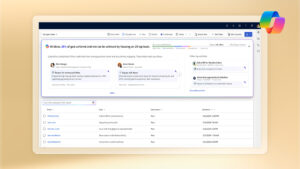
Dynamics 365 breathes composability into enterprise resource planning modernization
Retail executives have long understood the critical role that supply chain management plays in their organization’s ability to meet customer demand. Yet, as central as the supply chain is to success in most companies, customers rarely consider it when placing an order. This status quo shifted dramatically during the pandemic as high-profile disruptions and global shortages pushed supply chain from the boardroom to the forefront of consumer awareness. It has also cemented supply chain as a top priority for retailers, direct-to-consumer manufacturers, and distributors in the consumer goods sector––many of whom are embarking on enterprise resource planning (ERP) modernization. In this blog, we discuss composability for retailers alongside three customer success stories that showcase how Microsoft Dynamics 365 breathes composability into ERP modernization.
Composability for retailers
A composable business is an organization consisting of modular building blocks that can be orchestrated to rapidly adapt operations to changing market conditions, new business opportunities, and unpredictable disruptions. Unfortunately, while many sectors are reaping large benefits from composability, retailers have been slower to adopt a flexible approach. When Gartner® asked retailers if they accept the risk and costs of new technology and deploy it as early as possible, only eight percent of retailers agree, compared to 21 percent for highly composable business.1 One company that certainly exemplifies the value that a composable approach can create is Signature Cosmetics.
Signature Cosmetics
Signature Cosmetics, a leading cosmetics and fragrance group, based in South Africa, began a modernization program in 2019 to rationalize the complexity that years of steady growth brought to its supply chain. When they embarked, the retailer was hard pressed with even simple tasks, like determining accurate product cost and margin. Operating three divisions (manufacturing, imports, and retail) in four countries, each with siloed and separate systems, had made even routine decision making extremely difficult.
When the company began its modernization program by implementing Dynamics 365 Finance and Operations, it was not immediately clear the value that a composable solution would provide. As the pandemic hit, it quickly understood that a pivot in strategy was necessary. Because of the composable nature of the Dynamics 365 platform, it was able to rapidly stand up a new e-commerce site in less than two months, becoming the first Dynamics 365 e-commerce solution in the Middle East and Africa (MEA) region. The company quickly went from zero online sales at the onset of the pandemic to a 20-30 percent revenue growth in its first few months.
“Pivoting to an e-commerce platform has really opened the doors for them for new revenue opportunities.”—Mario Engelbrecht, Chief Technology Officer, Parity Software (Implementation partner).
Learn more: Signature Cosmetics customer story.
Inventory visibility
At Microsoft, we believe in the value that composability can bring to retailers. With new enhancements to our solutions, such as our Inventory Visibility Add-in for Dynamics 365 Supply Chain Management, retailers can begin their composability journey without significant risk or cost.
Our Inventory Visibility Add-in is a highly scalable microservice that enables real-time on-hand inventory tracking. The solution can easily connect and pull inventory from multiple third-party systems, allowing companies to create a single, global view of all inventories. By creating one pool of global inventory from which all orders can pull, companies can often increase inventory accuracy and thereby maximize sales opportunities. Plus, when coupled with the soft reservation capability, sales order fulfillment can avoid over-selling, effectively mitigating the risk of missed sales opportunities that may challenge some organizations. Ultimately, with the Inventory Visibility Add-in, users can compose a bespoke inventory system that delivers superior business value by meeting the unique needs of your operating model.
Learn more about composable solutions and microservice architectures in our blog: Dynamics 365 composable approach enables rapid deployment of a supply chain control tower.
Post-purchase experiences
According to the National Retail Federation (NRF), total returns increased from $428 billion in 20202, to $761 billion in 20213, an increase of more than 65 percent. While the growth in retail sales certainly accounts for a corresponding rise in returns, this may not be the entire story. Indeed, a 2021 Incisive survey of over 6,000 consumer transactions found that 73 percent of returns occurred due to a retailer-controlled action or inaction.4 In light of this fact, it is not surprising that savvy consumer goods companies are not inclined to treat returns as a necessary cost of doing business. Instead, they are working aggressively to stop returns from ever occurring while also focusing on reducing the operational cost of supporting the returns that they must support.
After all, it isn’t realistic to reduce returns entirely, which is why providing a quick and easy return mechanism is an essential part of delivering a quality post-purchase experience to consumers, particularly for online buyers. Still, e-commerce complexity and digital demand continue to grow, and many organizations are challenged to provide a seamless returns process. With initiatives such as our multiyear collaboration with FedEx, Microsoft is changing this situation for retailers.
We recently announced that the next step of our partnership with FedEx brings a unique integration to Dynamics 365 Intelligent Order Management. The integration, which begins the preview on April 30, 2022, will help brands deliver modern, high-value post-purchase experiences directly to their customers, including convenient, seamless returns. Users of Dynamics 365 Intelligent Order Management will gain the ability to allow their customers to take advantage of over 60,000 FedEx drop-off locations, convenient at-home pick-up, and paperless/label-less returns with easy-to-use QR codes, at no additional cost. One company that is leveraging Dynamics 365 to overcome the unique challenges of today’s retail supply chain is FOCO.
FOCO
As you saw during the Microsoft Business Applications Launch Event, FOCO, which is a leading manufacturer of sports and entertainment merchandise, including apparel, accessories, toys, collectibles, novelty items, and more, needs to provide a seamless returns experience for its customers. They can use the new FedEx integration returns management app to do so. As others discussed here, this composable microservice solution plugs into its existing e-commerce application.
FOCO can provide its customers with an intuitive, guided self-service returns experience. The process captures just enough information to coordinate a refund or exchange, requiring customers to visit a drop-off location of their choice and scan a simple QR code to complete the return––meeting consumer expectations with minimal effort. The process wraps up neatly for FOCO too. The solution combines multiple return items across multiple return points into a consolidated return shipment to the warehouse. Composable solutions like these make the post-purchase experience delightfully simple for the customer while also reducing the operational burden of the returns process for companies.
Enterprise resource planning (ERP) modernization
Dynamics 365 Supply Chain Management and Dynamics 365 Finance offer businesses two standardized ERP capabilities on a composable ERP platform, functioning as stand-alone solutions or as a tightly integrated and extensible system. As product-centric enterprises look to renovate their existing ERP platform to improve systems and processes by moving them to the cloud, Dynamics 365 is enabling the transformation and improving IT agility to deliver business outcomes in the process. Another company using Dynamics 365 for ERP modernization is Simply Good Foods Company.
The Simply Good Foods Company
The Simply Good Foods Company was formed by merging two well-known brands, Atkins and Quest. Before the merger, Quest modernized its ERP system by upgrading to Dynamics 365 Supply Chain Management and Dynamics 365 Finance. One of the aims of the merger was to standardize business operations between the two companies, which led Atkins to join the implementation of the new ERP solution.
While challenging to complete alongside the merger, broadening the implementation enabled The Simply Good Foods Company to consolidate master data, increase third-party logistics, and improve its sales order process productivity—all without sacrificing reporting independence. Today, the company goes to market as a multi-brand retailer, presenting a unified face to its customers but reaping the operational benefits from economies of scale created by the merger.
Learn more: The Simply Good Foods Company customer story.
What’s next?
In addition to the customer stories and new features covered here, we are honored that Gartner has recognized Microsoft as a Leader in the 2021 Gartner Magic Quadrant for Cloud ERP for Product-Centric Enterprises for Microsoft Dynamics 365. To learn more, please check out the Gartner Magic Quadrant and visit our Build a Resilient and Sustainable Supply Chain webinar.
Sources:
Gartner does not endorse any vendor, product or service depicted in its research publications and does not advise technology users to select only those vendors with the highest ratings or other designation. Gartner research publications consist of the opinions of Gartner’s Research & Advisory organization and should not be construed as statements of fact. Gartner disclaims all warranties, expressed or implied, with respect to this research, including any warranties of merchantability or fitness for a particular purpose.
GARTNER and MAGIC QUADRANT are trademarks and service marks of Gartner, Inc. and/or its affiliates and are used herein with permission. All rights reserved.
2- NRF, 2021. $428 billion in Merchandise Returned in 2020.
3- NRF, 2022. Retail Returns Increased to $761 Billion in 2021 as a Result of Overall Sales Growth.
4- Incisiv, 2021. State of the Industry Report: Retail Returns.




